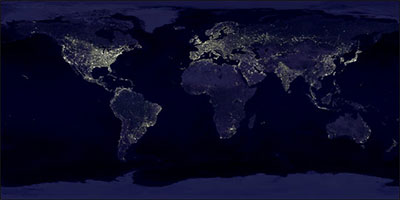In recognition of the fortieth anniversary of Earth Day, Indiana University of Pennsylvania's chapter of Sigma Xi scientific honor society is sponsoring a presentation by a NASA scientist.
Dr. Marc Imhoff, a NASA Terra project scientist, will present “Gray Wave of the Great Transformation: A Satellite View of Urbanization, Climate Change and Food Security” on April 27, 2010, at 7:30 p.m. in IUP's Eberly Auditorium. The program is free and open to the community.
Terra is a multinational, multidisciplinary mission involving partnerships with the aerospace agencies of Canada and Japan. Most recently, scientists involved in the Terra mission are studying the ash from Iceland's Eyjafjallajökull volcano.
In his role at NASA, Imhoff coordinates an international research team using Terra and other instruments to study Earth's changing atmosphere, oceans, and land surface. He has personally conducted research on a wide range of topics including the impact of urbanization on biodiversity and food security, urban heat islands and climate, and carbon accounting using remote sensing for the Kyoto Protocol.
He was a primary developer of the nighttime satellite imagery showing Earth's cities at night and pioneered the use of radar sensors for terrain and vegetation mapping.
“Land cover change driven by human activity is profoundly affecting Earth's natural systems with impacts ranging from a loss of biological diversity to changes in regional and global climate,” Imhoff said.
“Fortunately we have incredible new tools for planning and developing urban places that are both enjoyable and sustainable. A suite of Earth observing satellites is making it possible to study the interactions between urbanization, biological processes, and weather and climate.
“Using these Earth observatories, we are learning how urban heat islands form and potentially ameliorate them, how urbanization can affect rainfall, pollution, and surface water recharge at the local level and climate and food security globally.”
